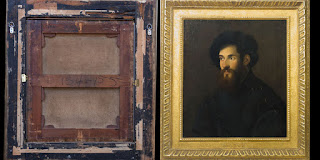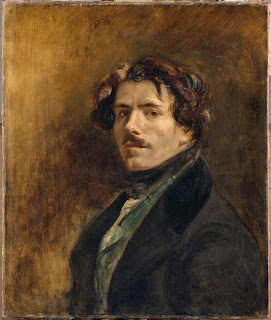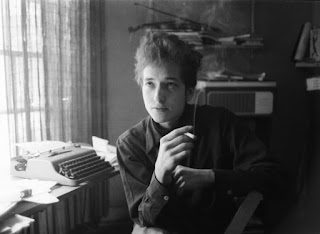Museum Shows Challenges
Provenance Exhibition at Krannert Art Museum Shows Challenges of WWII-era Research
CHAMPAIGN, Ill. — Nancy Karrels relishes solving the mysteries behind the paintings and objects we see in art museums, especially here at Krannert Art Museum at the University of Illinois Urbana-Champaign.
Karrels – a doctoral student in art history at Illinois who also has two law degrees – investigates the backgrounds and histories of objects to trace their path from creator through each owner. She has created an exhibition for Krannert Art Museum on provenance research and her efforts to document the history of ownership of several of the museum’s works. “Provenance: A Forensic History of Art” opens May 13 and runs through June 2018.
Provenance, or the history of ownership of a historical object or work of art, is important to museums and private collectors, both to authenticate the object and to ensure that ownership is legal and the object was not looted. The practice has drawn more attention in the last couple of decades as artwork stolen by the Nazis before and during World War II has been identified and returned to its owners or their heirs.
U.S. museums, including Krannert Art Museum, voluntarily put information online on the Nazi-Era Provenance Internet Portal about any works that lack an unbroken provenance for the Nazi era. The database helps people searching for stolen art.
“Most are not looted artworks. There are almost 30,000 objects on the list,” said Maureen Warren, Krannert Art Museum’s curator of European and American art, who worked with Karrels on the provenance exhibition.
Of the thousands of works in Krannert’s collection, 24 are listed on the database. That doesn’t necessarily mean there are problems with the ownership of the items, but that there is a gap in the paper trail of ownership that requires closer scrutiny.
“It’s our ethical obligation to conduct this research,” Warren said. “All of our curators make it part of their regular practice, with both new acquisitions and our existing collection. We will not acquire something that is questionable with regard to export laws and other regulations. We have declined to accept gifts that could be suspect in that regard. That doesn’t mean we won’t take things that have gaps (in documentation), but we consider the appropriate legal framework and try to err on the side of caution.”
Karrels has been looking at artwork in the museum’s foundational collection of European paintings that was created after 1932 and traded before 1946 – items that might have changed hands during the time period when the Nazis were stealing artwork. She looked at 28 paintings and established an unbroken line of ownership for four paintings, and she is close to doing so for a fifth.
“Often you know where something was, but there’s a lack of evidence to prove it. You strive to build an airtight case,” she said.
The exhibition shows the methods provenance researchers use to trace the history of a painting. First, there is physical evidence in the form of stamps or labels on the back of paintings – an export stamp or a label from a museum, auction house or exhibition. A researcher can then study catalogs for museums or auction houses, customs receipts, ship manifestos, wills and other documents for more information about the artwork.
The work at the center of the exhibition is a painting by Moretto da Brescia titled “Portrait of an Unidentified Man.” Visitors will be able to see the Austrian export stamp on the back of the painting. The stamp was used between 1934 and 1938, including a five-month period during which the Nazis occupied the country and were looting artwork. Karrels has been working with the Austrian office of cultural exports, trying to locate the export document, but so far has been unable to match a file to the painting.
The exhibition also includes a Flemish painting attributed to the Master of the Saint Ursula Legend. Paperwork associated with the painting has the names of several women, and they are similar enough that Karrels initially thought it might be successive generations of women from the same family. After searching genealogical records and the society pages of a New York newspaper, Karrels discovered the names referred to one woman who changed her name several times through marriage. That painting now has an unbroken provenance during the Nazi era and has been removed from the Nazi-Era Provenance Internet Portal database.
Similar issues can arise when a painting is thought to be the creation of one artist but is later attributed to a different artist, or when the title or description of the painting changes over the years. The dimensions of a painting can even change. Collectors sometimes cut down a work of art to make it fit better on a wall or because they don’t like a portion of the composition, Warren said.
“I’m fascinated by how provenance research brings together scholarship and detective work,” Karrels said. “There’s also a certain amount of creativity. Where can I find the sources of information I need? And finally, there is a great deal to be said for the network of scholars that collaborate across disciplines and geographic boundaries with the mutual objectives of reconstructing provenances in museum collections and fulfilling ethical obligations.
“One thing I especially wanted to convey with this exhibition is the ambiguity inherent in provenance research. Most of the time, as hard as we try, we cannot resolve issues of provenance because vital documents don’t exist or aren’t accessible,” Karrels said. “This whole subject is much more nuanced than how it’s represented in the press and in film. I think our exhibition gives viewers a greater understanding of the complexities and uncertainties in provenance research, and why those exist.”
CONTACT: Jodi Heckel, University of Illinois News Bureau, Arts and Humanities Editor 217-300-2751; jeheckel@illinois.edu




Comments
Post a Comment
Thank you for your response
Kind regards Pierre